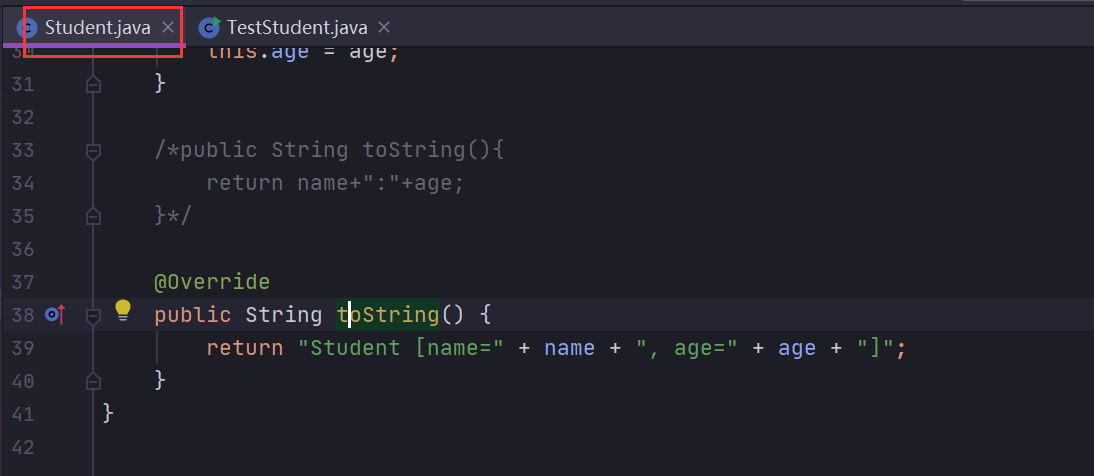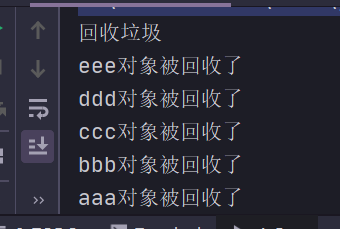Java常用类之Object类
基本作用:
-
超类、基类,所有类的直接或间接父类,位于继承树的最顶层(食物链最顶端的男人)。
-
任何类,如没有书写extends显示继承某个类,默认直接继承Object类,否则为间接继承。
-
Object类所定义的方法,是所有对象都具备的方法。
-
Object类型可以存储任何对象。
-
作为参数,可以接受任何对象。
-
作为返回值,可以返回任何对象。
-
常用方法:
| 描述 | |
|---|---|
| public final Class<?> getClass() | 返回此 Object 的运行时类。 |
| public int hasCode() | 返回该对象的哈希码值。 |
| public String toString() | 返回该对象的字符串表示。 |
| public boolean equals(Object obj) | 指示其他某个对象是否与此对象“相等”。 |
| protected void finalize() throws Throwable | 当垃圾回收器确定不存在对该对象的更多引用时,由对象的垃圾回收器调用此方法。 |
getClass()方法
-
-
返回引用中存储的实际对象类型。
-
应用:通常应用于判断两个引用中实际存储对象类型是否一只致。
package lesson01;
public class Student {
private String name;
private int age;
public Student(){
}
public Student(String name, int age) {
super();
this.name = name;
this.age = age;
}
public String getName() {
return name;
}
public void setName(String name) {
this.name = name;
}
public int getAge() {
return age;
}
public void setAge(int age) {
this.age = age;
}
}
package lesson01;
public class TestStudent {
public static void main(String[] args) {
Student s1 = new Student("aaa",20);
Student s2 = new Student("bbb",22);
//判断s1和s2是不是同一个类型
Class class1 = s1.getClass();
Class class2 = s2.getClass();
if (class1 == class2){
System.out.println("s1和s2属于同一个类型");
}else {
System.out.println("s1和s2不属于同一个类型");
}
}
}

hashCode()方法
-
public int hasCode(){}
-
返回该对象的哈希码值。
-
哈希值根据对象的地址或字符串或数字使用hash算法计算出来的
int类型的数值。 -
一般情况下,相同对象返回相同哈希码
package lesson01;
public class Student {
private String name;
private int age;
public Student(){
}
public Student(String name, int age) {
super();
this.name = name;
this.age = age;
}
public String getName() {
return name;
}
public void setName(String name) {
this.name = name;
}
public int getAge() {
return age;
}
public void setAge(int age) {
this.age = age;
}
}
package lesson01;
public class TestStudent {
public static void main(String[] args) {
Student s1 = new Student("aaa",20);
Student s2 = new Student("bbb",22);
//hashCode方法
System.out.println(s1.hashCode());
System.out.println(s2.hashCode());
}
}

toString()方法
-
返回该对象的字符串表示形式(表现形式)。
-
可以根据程序需求重写该方法。如:展现对象各个属性值
-
对象输出时,会调用Object类中的toString()方法打印
package lesson01;
public class TestStudent {
public static void main(String[] args) {
Student s1 = new Student("aaa",20);
Student s2 = new Student("bbb",22);
//ToString方法
System.out.println(s1.toString());
System.out.println(s2.toString());
}
}

我们看一下toString的源码:

我们重写toString的源码:

查看运行结果:

equals()方法
-
默认实现为(this==obj),比较两个对象地址是否相同。
-
可进行重写,比较两个对象的内容是否相同。
-
在String类中已经实现好了此方法,所以用户可直接进行两个字符串对象的比较
package lesson01;
public class TestStudent {
public static void main(String[] args) {
Student s1 = new Student("aaa",20);
Student s2 = new Student("bbb",22);
//equals方法,判断两个对象是否相等
System.out.println(s1.equals(s2));
Student s4 = new Student("小明", 12);
Student s5 = new Student("小明", 12);
System.out.println(s4.equals(s5));
}
}
测试结果:

equals()方法覆盖步骤:
-
比较两个引用是否指向同一个对象
-
判断obj是否为null
-
判断两个引用指向的实际对象类型是否一致
-
强制类型转换
-
依次比较各个属性值是否相同
重写equals()方法
package lesson01;
public class Student {
private String name;
private int age;
public Student(){
}
public Student(String name, int age) {
super();
this.name = name;
this.age = age;
}
public String getName() {
return name;
}
public void setName(String name) {
this.name = name;
}
public int getAge() {
return age;
}
public void setAge(int age) {
this.age = age;
}
/*public String toString(){
return name+":"+age;
}*/
@Override
public String toString() {
return "Student [name=" + name + ", age=" + age + "]";
}
//重写equals方法
@Override
public boolean equals(Object obj) {
//1、判断两个对象是否是同一个引用
if (this == obj) {
return true;
}
//2、判断obj是否null
if (obj==null){
return false;
}
//3、判断是否是同一类型
// 这个有点笨重,不太好
// if (this.getClass()==obj.getClass()){
// }
if (obj instanceof Student){
//4、强制类型转换,instanceof 可以判断对象是否是某种类型
Student s=(Student) obj;
//5、比较属性
if (this.name.equals(s.getName())&&this.age==s.getAge()){
return true;
}
}
return false;
}
}
测试结果:

finalize()方法
-
protected void finalize() throws Throwable{}
-
当对象被判定为垃圾对象时,由JVM自动调用此方法,用以标记垃圾对象,进入回收对列。
-
垃圾对象:没有有效引用指向此对象时,为垃圾对象。
-
垃圾回收:由GC销毁垃圾对象,释放数据存储空间。
-
自动回收机制:JVM的内存耗尽,一次性回收所有垃圾对象。
-
手动回收机制:使用System.gc();通知JVM执行垃圾回收。
重写finalize()方法:
@Override
protected void finalize() throws Throwable {
System.out.println(this.name+"对象被回收了");
}

package lesson01;
public class TestStudent {
public static void main(String[] args) {
Student s1 = new Student("aaa",20);
Student s2 = new Student("bbb",22);
//equals方法,判断两个对象是否相等
System.out.println(s1.equals(s2));
Student s4 = new Student("小明", 12);
Student s5 = new Student("小明", 12);
System.out.println(s4.equals(s5));
}
}
测试结果:

略微修改:
package lesson01;
public class TestStudent2 {
public static void main(String[] args) {
// Student s1 = new Student("aaa", 23);
// Student s2 = new Student("bbb", 23);
// Student s3 = new Student("ccc", 23);
// Student s4 = new Student("ddd", 23);
// Student s5 = new Student("eee", 23);
new Student("aaa", 23);
new Student("bbb", 23);
new Student("ccc", 23);
new Student("ddd", 23);
new Student("eee", 23);
//回收垃圾
System.gc();
System.out.println("回收垃圾");
}
}
测试结果:

再次运行:

总结
- 实际开发中的作用,由于Object类可以接收任意的引用数据类型,所以在很多的类库设计上都采用Object作为方法的参数,这样操作起来更方便。
- Object类中还有一些方法如wait()、notify()等通常用在线程上,本文未介绍,后期学习线程方面的知识再进行相应的补充。






【推荐】国内首个AI IDE,深度理解中文开发场景,立即下载体验Trae
【推荐】编程新体验,更懂你的AI,立即体验豆包MarsCode编程助手
【推荐】抖音旗下AI助手豆包,你的智能百科全书,全免费不限次数
【推荐】轻量又高性能的 SSH 工具 IShell:AI 加持,快人一步
· 阿里最新开源QwQ-32B,效果媲美deepseek-r1满血版,部署成本又又又降低了!
· AI编程工具终极对决:字节Trae VS Cursor,谁才是开发者新宠?
· 开源Multi-agent AI智能体框架aevatar.ai,欢迎大家贡献代码
· Manus重磅发布:全球首款通用AI代理技术深度解析与实战指南
· 被坑几百块钱后,我竟然真的恢复了删除的微信聊天记录!